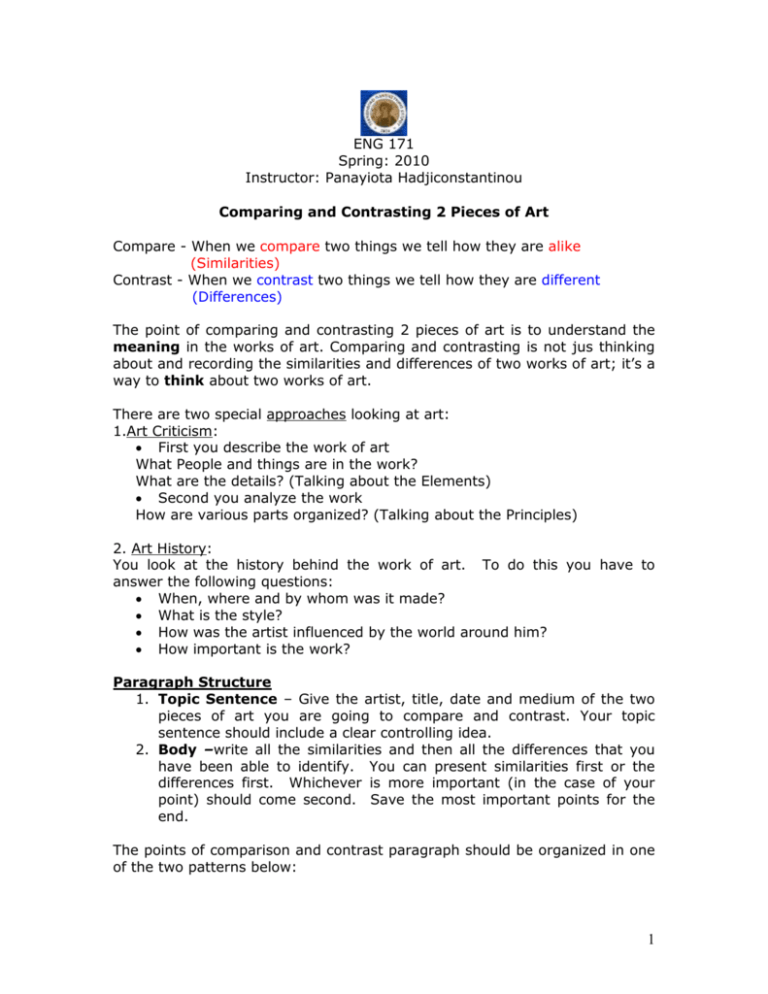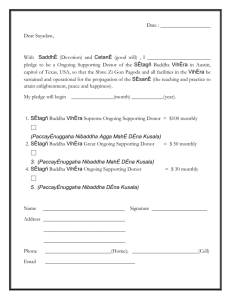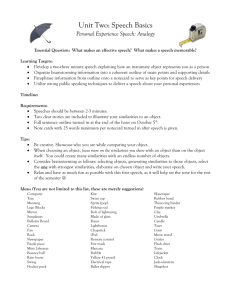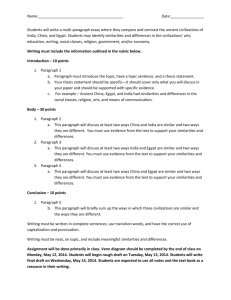Comparing and Contrasting 2 Pieces of Art
advertisement

ENG 171 Spring: 2010 Instructor: Panayiota Hadjiconstantinou Comparing and Contrasting 2 Pieces of Art Compare - When we compare two things we tell how they are alike (Similarities) Contrast - When we contrast two things we tell how they are different (Differences) The point of comparing and contrasting 2 pieces of art is to understand the meaning in the works of art. Comparing and contrasting is not jus thinking about and recording the similarities and differences of two works of art; it’s a way to think about two works of art. There are two special approaches looking at art: 1.Art Criticism: First you describe the work of art What People and things are in the work? What are the details? (Talking about the Elements) Second you analyze the work How are various parts organized? (Talking about the Principles) 2. Art History: You look at the history behind the work of art. To do this you have to answer the following questions: When, where and by whom was it made? What is the style? How was the artist influenced by the world around him? How important is the work? Paragraph Structure 1. Topic Sentence – Give the artist, title, date and medium of the two pieces of art you are going to compare and contrast. Your topic sentence should include a clear controlling idea. 2. Body –write all the similarities and then all the differences that you have been able to identify. You can present similarities first or the differences first. Whichever is more important (in the case of your point) should come second. Save the most important points for the end. The points of comparison and contrast paragraph should be organized in one of the two patterns below: 1 1. Present all the information about A and then provide parallel information about B: First all A: point 1 point 2 point 3 Then all B: point 1 point 2 point 3 2. Move back and forth between A and B. Present one point about A and then go to the parallel point about B. Then move to the next point and do the same: First A, point 1; then B, point 1 First A, point 2; then B, point 2 First A, point 3; then B, point 3 The second pattern makes it easier for the reader to keep the contrasts or comparisons in mind. Concluding Sentence- sum up what you have said, supporting your initial statement Transitional Expressions You should also use transitional expressions that either stress differences or similarities. Transitional Expressions that stress opposition and difference: although whereas but however in contrast on the other hand yet unlike while Transitional Expressions that stress similarities: in the same way in addition Example: as well as also and both just as…so the same neither similarly like too Two religious paintings, the Tathagata Buddha from Tibet and 2 Example: Two religious paintings, the Tathagata Buddha from Tibet and Cimabue’s Madonna Enthroned from Italy, were created four thousand miles apart and for different religions, so they are quite different in content; nevertheless, they are surprisingly similar in form. The Tathagata Buddha is, of course, a Buddhist painting, and Madonna Enthroned is Christian. The Buddha, the central figure in the Tathagata Buddha, isn’t holding anything; in contrast, the Virgin Mary, the central figure in Madonna Enthroned, is holding the baby Jesus. The Buddha is wearing very little clothing except for elaborate jewelry, while the Virgin Mary is wearing long robes. Furthermore, by analyzing the two pieces of art it can be seen that there is more space around Buddha, whereas there is less empty space around Madonna Enthroned. Another striking difference, although both paintings are black and white, is that the use of value is different. The Tathagata Buddha has less value than Madonna Enthroned, which is darker. However, these paintings have more similarities than differences. Both were created in the 13th century and have a large central figure facing front, on which emphasis is given because of its large size. The central figure in each painting has a calm, serene expression creating harmony, which can also be seen through the use of similar elements throughout both works. Both central figures have a symbolic hand gesture. The Buddha’s hand position symbolizes the giving of gifts, while Mary gestures toward her son, symbolic of the hope of the world. Another similarity is that, both the Buddha and the Virgin Mary are surrounded by smaller figures wearing halos. In the Tathagata Buddha, these smaller figures, bodhisattvas, help people to reach Nirvana. Similarly, the angels surrounding the Virgin Mary help people to reach heaven. Finally, both works have unity and are balanced – this can be seen through the repetition of same shapes and lines. Clearly, two artists unknown to each other created quite similar paintings for their different religions. (Adapted from: Quest 2, Reading and Writing, Pamela Hartmann) Activity 1: Find the Topic Sentence Find the Concluding Sentence Highlight the transitional expressions used How many similarities can you find? How many differences can you find? Which come first (the similarities or the differences)? Why? Activity 2: Get in groups of 3, click on the following links to see the two pieces of art and use the Compare and Contrast Worksheet to compare and contrast them. 3 Swans Reflecting Elephants Salvador Dali, 1937, Oil on canvas, Dimensions:20.08 in × 30.31 in Information about the Painting: http://en.wikipedia.org/wiki/Swans_Reflecting_Elephants The Persistence of Memory, Salvador Dali, 1931, Oil on Canvas, Dimensions24 cm × 33 cm (9.5 in × 13 in) 4 Information about the Painting: http://www.moma.org/collection/browse_results.php?object_id=79018 Information about Salvador Dali: http://library.thinkquest.org/J001159/famart.htm As a group write a first draft paragraph that compares and contrasts the two works of art. Try to look for some new meaning or see something important that you would not have understood without comparing. By Wednesday 24th February 2010, e-mail your paragraph to another group of classmates for feedback. Remember that feedback should be constructive and you should give suggestions rather than criticisms. Once your first drafts and written feedback are returned, you should complete a final draft of comparison and contrast of two pieces of art paragraph, and e-mail it to me by 26th February, 2010. After you receive my e-mail and make any necessary changes, upload it on your wiki (writing the group members’ names), by 29th February, 2010. Note: You can use the Describing a Piece of Art Worksheet (explaining the elements of art) given to you in Week 2, and the Principles of Art Handout given to you in Week 3. Checklist: Consider the following when writing your paragraph: The layout of the paragraph is correct (indentation, margins). There is a topic sentence that includes the main topic and a controlling idea. The titles of the items are in italics. There are at least three similarities between the items. There are at least three differences between the items. There is a clear alternative pattern. The most important points are last. There is correct use of transition words. There is a concluding sentence. 5 6






